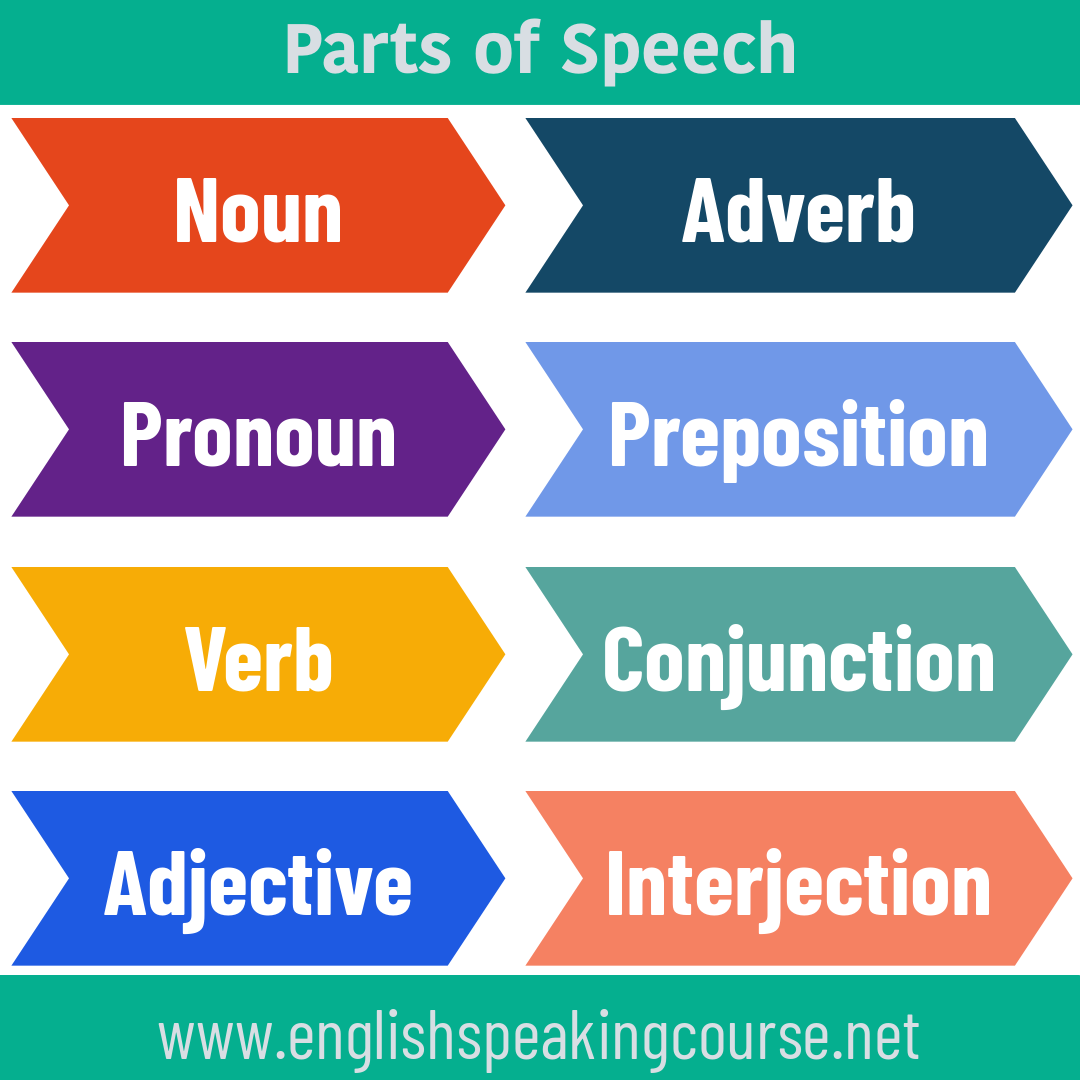Table of Contents
ToggleWhats are Parts of Speech?
Parts of Speech for Beginners: Let’s dive into the basic parts of speech along with their definitions, examples, and functions in sentences. Parts of speech are the fundamental building blocks of language, and they help us understand how words are used in sentences.
1. Noun:
– Definition: A noun is a word that represents a person, place, thing, or idea.
– Examples: cat, book, London, happiness
– Function: Nouns can act as the subject of a sentence (“The cat is sleeping.”), the object of a verb (“She read a book.”), or the object of a preposition (“He lives in London.”).
2. Pronoun:
– Definition: A pronoun is a word used to replace a noun, avoiding repetition.
– Examples: he, she, it, they, I, you
– Function: Pronouns help make sentences less repetitive. For example, “She is going to the park” instead of “Mary is going to the park.”
3. Verb:
– Definition: A verb is a word that describes an action, occurrence, or state of being.
– Examples: run, eat, sleep, is, were
– Function: Verbs can be the main action of a sentence (“She runs every morning.”) or help in forming verb tenses and moods (“They were singing yesterday.”).
4. Adjective:
– Definition: An adjective is a word that describes or modifies a noun.
– Examples: blue, tall, delicious, happy
– Function: Adjectives provide additional information about nouns, making sentences more descriptive (“The tall tower is impressive.”).
5. Adverb:
– Definition: An adverb is a word that modifies a verb, adjective, or another adverb, indicating how, when, where, or to what degree.
– Examples: quickly, very, often, here
– Function: Adverbs provide more details about verbs or other parts of speech, giving a clearer picture of the action (“She ran quickly.”).
6. Preposition:
– Definition: A preposition is a word that shows the relationship between a noun (or pronoun) and other words in a sentence.
– Examples: in, on, under, between
– Function: Prepositions indicate location, direction, time, or manner (“The cat is under the table.”).
7. Conjunction:
– Definition: A conjunction is a word that connects words, phrases, or clauses.
– Examples: and, but, or, because
– Function: Conjunctions help join ideas, showing how different parts of a sentence relate to each other (“I wanted to go, but it started raining.”).
8. Interjection:
– Definition: An interjection is a word or phrase that expresses strong emotions or sudden exclamations.
– Examples: wow, oh, ouch, hooray
– Function: Interjections convey emotions and reactions, often standing alone or at the beginning of a sentence (“Wow! That’s amazing.”).
Understanding these basic parts of speech is crucial for constructing and comprehending sentences in any language. They form the foundation for more complex grammatical structures and allow us to communicate effectively.
The Noun
Parts of Speech for Beginners:
Certainly! Nouns can be categorized into different types based on their characteristics and roles in a sentence. Here are some common types of nouns along with examples and details:
1. Common Noun:
– Definition: A common noun refers to a general person, place, thing, or idea. It doesn’t specify a particular one.
– Examples: cat, city, book, happiness
– Details: Common nouns are not capitalized unless they appear at the beginning of a sentence. They represent ordinary, everyday objects.
2. Proper Noun:
– Definition: A proper noun is the specific name of a person, place, organization, or thing. It is capitalized.
– Examples: Mary, Paris, Google, Statue of Liberty
– Details: Proper nouns are unique and distinct entities, and they always start with a capital letter.
3. Concrete Noun:
– Definition: A concrete noun refers to something that can be perceived through the senses (sight, touch, taste, hearing, or smell).
– Examples: table, flower, chocolate, music
– Details: Concrete nouns are tangible and can be experienced directly.
4. Abstract Noun:
– Definition: An abstract noun refers to a concept, idea, emotion, or quality that cannot be perceived through the senses.
– Examples: love, freedom, happiness, knowledge
– Details: Abstract nouns represent intangible concepts that exist beyond physical experiences.
5. Collective Noun:
– Definition: A collective noun refers to a group of people, animals, or things as a single entity.
– Examples: team, herd, family, flock
– Details: Collective nouns treat a group as a singular unit, even though it consists of multiple individuals.
6. Countable Noun (Count Noun):
– Definition: A countable noun can be counted as individual units.
– Examples: apple, chair, dog, book
– Details: Countable nouns have plural forms and can be quantified (e.g., “two dogs”).
7. Uncountable Noun (Mass Noun):
– Definition: An uncountable noun refers to something that is not typically counted as separate units.
– Examples: water, rice, information, happiness
– Details: Uncountable nouns are often substances, concepts, or qualities and are not given plural forms (e.g., “information,” not “informations”).
8. Compound Noun:
– Definition: A compound noun is formed by combining two or more words to create a single noun.
– Examples: toothbrush, basketball, mother-in-law
– Details: Compound nouns can be written as separate words, hyphenated, or combined as one word.
9. Possessive Noun:
– Definition: A possessive noun shows ownership or possession of something.
– Examples: John’s car, the cat’s tail, the company’s success
– Details: Possessive nouns are formed by adding an apostrophe and an “s” (‘s) to the end of the noun.
Understanding these different types of nouns helps us use language more precisely and effectively by conveying specific meanings and relationships within sentences.
The Pronoun
Parts of Speech for Beginners:
Pronouns are words that replace nouns to avoid repetition and make sentences more concise. There are various types of pronouns, each serving a specific purpose in a sentence. Here are the main types of pronouns, along with examples and details:
1. Personal Pronouns:
– Definition: Personal pronouns refer to specific persons or things and indicate the role they play in a sentence (subject, object, possessive).
– Examples: I, you, he, she, it, we, they
– Details: Personal pronouns change form based on their function in a sentence. For instance, “I” is used as a subject (“I am happy”), while “me” is used as an object (“He gave it to me”).
2. Reflexive Pronouns:
– Definition: Reflexive pronouns refer back to the subject of a sentence and emphasize that the action affects the subject itself.
– Examples: myself, yourself, himself, herself, itself, ourselves, yourselves, themselves
– Details: Reflexive pronouns are used when the subject and the object of the sentence are the same, such as “She washed herself.”
3. Intensive Pronouns:
– Definition: Intensive pronouns also emphasize the subject of a sentence, but they don’t necessarily have to be there for the sentence to make sense.
– Examples: myself, yourself, himself, herself, itself, ourselves, yourselves, themselves
– Details: Intensive pronouns emphasize the subject’s identity or action, as in “I myself completed the project.”
4. Demonstrative Pronouns:
– Definition: Demonstrative pronouns point to specific people, places, or things and indicate their relative distance from the speaker.
– Examples: this, that, these, those
– Details: Demonstrative pronouns help clarify which specific object or objects are being referred to, such as “This is my book.”
5. Relative Pronouns:
– Definition: Relative pronouns introduce relative clauses, which provide additional information about a noun in the sentence.
– Examples: who, whom, whose, which, that
– Details: Relative pronouns connect two parts of a sentence, such as “The person who won is my friend.”
6. Interrogative Pronouns:
– Definition: Interrogative pronouns are used to ask questions and gather information about people or things.
– Examples: who, whom, whose, which, what
– Details: Interrogative pronouns help formulate questions, such as “Who is coming to the party?”
7. Indefinite Pronouns:
– Definition: Indefinite pronouns refer to nonspecific people or things and often don’t have a clear antecedent.
– Examples: all, some, everyone, something, nobody, each, any
– Details: Indefinite pronouns help express a general idea, as in “Someone left their umbrella.”
8. Possessive Pronouns:
– Definition: Possessive pronouns indicate ownership or possession of something and replace possessive nouns.
– Examples: mine, yours, his, hers, its, ours, theirs
– Details: Possessive pronouns show who owns or possesses something, like “The book is yours.”
9. Reciprocal Pronouns:
– Definition: Reciprocal pronouns indicate a mutual action or relationship between two or more people or things.
– Examples: each other, one another
– Details: Reciprocal pronouns are used in sentences like “They love each other.”
Understanding these different types of pronouns and their functions helps you communicate more effectively and avoid unnecessary repetition in your sentences.
The Verb
Parts of Speech for Beginners:
Verbs are essential components of sentences that express actions, states of being, or occurrences. They can be classified into several types based on their functions and characteristics. Here are the main types of verbs, along with examples and details:
1. Action Verbs:
– Definition: Action verbs express physical or mental actions that someone or something performs.
– Examples: run, eat, read, think, dance
– Details: Action verbs can be either transitive (require a direct object, like “She reads a book”) or intransitive (do not require a direct object, like “He dances”).
2. Linking Verbs:
– Definition: Linking verbs connect the subject of a sentence with a subject complement, often describing a state of being or condition.
– Examples: be (am, is, are, was, were), seem, become, feel
– Details: Linking verbs do not show action; instead, they provide more information about the subject (“She is happy”).
3. Helping Verbs (Auxiliary Verbs):
– Definition: Helping verbs work alongside main verbs to create verb tenses, moods, and voices.
– Examples: have, has, had, do, does, did, will, would, can, could, may, might, shall, should, must
– Details: Helping verbs assist in forming different verb forms and expressing nuances in meaning (“She has gone to the store”).
4. Modal Verbs:
– Definition: Modal verbs express possibility, necessity, ability, permission, or obligation.
– Examples: can, could, may, might, will, would, shall, should, must
– Details: Modal verbs are used to convey the speaker’s attitude or degree of certainty about an action (“You must study for the exam”).
5. Transitive Verbs:
– Definition: Transitive verbs require a direct object to complete their meaning.
– Example: eat (transitive) – “She eats an apple.”
– Details: Transitive verbs show action that is done to something or someone else.
6. Intransitive Verbs:
– Definition: Intransitive verbs do not require a direct object to complete their meaning.
– Example: laugh (intransitive) – “He laughs.”
– Details: Intransitive verbs express actions that don’t transfer to an object.
7. Phrasal Verbs:
– Definition: Phrasal verbs are made up of a main verb and one or more particles (prepositions or adverbs), creating new meanings.
– Example: look up (phrasal) – “She looked up the word.”
– Details: Phrasal verbs often have idiomatic meanings that may not be directly related to the individual words.
8. Regular Verbs:
– Definition: Regular verbs follow a predictable pattern when forming their past tense and past participle by adding “-ed” to the base form.
– Example: play (regular) – “They played soccer yesterday.”
– Details: Regular verbs adhere to a consistent conjugation pattern.
9. Irregular Verbs:
– Definition: Irregular verbs do not follow the standard conjugation rules for forming past tense and past participle forms.
– Example: go (irregular) – “She went to the store.”
– Details: Irregular verbs have unique forms for their past tense and past participle.
Understanding these different types of verbs and how they function in sentences is essential for constructing clear and meaningful communication.
The Adjective
Parts of Speech for Beginners:
Adjectives are words that provide additional information about nouns by describing their attributes or qualities. They help add detail and depth to our language. Here are the main types of adjectives, along with examples and details:
1. Descriptive Adjectives:
– Definition: Descriptive adjectives provide specific characteristics or qualities about nouns.
– Examples: blue, tall, delicious, happy
– Details: Descriptive adjectives help paint a clearer picture of the noun’s appearance, nature, or condition (“She wore a beautiful dress.”).
2. Demonstrative Adjectives:
– Definition: Demonstrative adjectives indicate which specific noun is being referred to by showing its relative proximity.
– Examples: this, that, these, those
– Details: Demonstrative adjectives help specify whether the noun is nearby or distant (“This book is interesting.”).
3. Possessive Adjectives:
– Definition: Possessive adjectives show ownership or possession of a noun.
– Examples: my, your, his, her, its, our, their
– Details: Possessive adjectives indicate who possesses the noun (“His cat is adorable.”).
4. Quantitative Adjectives:
– Definition: Quantitative adjectives provide information about the quantity or number of a noun.
– Examples: some, all, few, many, several, five
– Details: Quantitative adjectives help convey how much or how many of something there is (“I have several books.”).
5. Qualitative Adjectives:
– Definition: Qualitative adjectives describe the qualities or characteristics of a noun without indicating how many there are.
– Examples: beautiful, intelligent, amazing, delicious
– Details: Qualitative adjectives add depth and detail to nouns by expressing their qualities or attributes (“He is an intelligent student.”).
6. Interrogative Adjectives:
– Definition: Interrogative adjectives are used to ask questions about a noun.
– Examples: which, what, whose
– Details: Interrogative adjectives help seek specific information about the noun (“Whose book is this?”).
7. Indefinite Adjectives:
– Definition: Indefinite adjectives refer to nonspecific quantities or qualities of a noun.
– Examples: some, any, several, many, few
– Details: Indefinite adjectives express a general idea without specifying exact numbers (“She gave me some advice.”).
8. Numeral Adjectives:
– Definition: Numeral adjectives indicate the number or order of nouns.
– Examples: one, two, first, second, tenth
– Details: Numeral adjectives provide specific numerical information about the noun (“She has two dogs.”).
9. Articles:
– Definition: Articles are a type of adjective that come before nouns and indicate definiteness (the) or indefiniteness (a, an).
– Examples: the, a, an
– Details: Articles help determine whether the noun is specific or nonspecific (“I saw a cat in the garden.”).
Understanding these various types of adjectives helps us create richer and more precise descriptions in our writing and speech. Adjectives add color, flavor, and clarity to our language by providing additional information about nouns.
The Adverb
Parts of Speech for Beginners:
Adverbs are versatile words that modify verbs, adjectives, other adverbs, or entire clauses to provide more information about how, when, where, or to what degree an action or quality occurs. Here are the main types of adverbs, along with examples and details:
1. Adverbs of manner:
– Definition: Adverbs of manner describe how an action is performed.
– Examples: quickly, softly, beautifully, carefully
– Details: They provide information about the way something is done (“She sings beautifully.”).
2. Adverbs of frequency:
– Definition: Adverbs of frequency indicate how often an action occurs.
– Examples: always, often, sometimes, rarely, never
– Details: They tell us the frequency or regularity of an action (“I often go jogging.”).
3. Adverbs of time:
– Definition: Adverbs of time specify when an action takes place.
– Examples: now, later, yesterday, soon, frequently
– Details: They provide information about the timing of an action (“We will leave soon.”).
4. Adverbs of place:
– Definition: Adverbs of place describe where an action occurs.
– Examples: here, there, nearby, everywhere, nowhere
– Details: They indicate the location of the action or the subject (“She looked everywhere for her keys.”).
5. Adverbs of degree:
– Definition: Adverbs of degree modify the intensity or extent of an action or quality.
– Examples: very, extremely, quite, almost, too
– Details: They show how much or to what extent an action is performed (“The food is very spicy.”).
6. Adverbs of certainty:
– Definition: Adverbs of certainty express the speaker’s level of confidence or doubt.
– Examples: certainly, definitely, maybe, probably, surely
– Details: They convey the speaker’s belief or uncertainty about the action (“She will definitely come to the party.”).
7. Adverbs of reason:
– Definition: Adverbs of reason explain why an action is performed.
– Examples: because, therefore, so, hence, thus
– Details: They provide the reason or cause behind an action (“He studied hard; therefore, he passed the exam.”).
8. Interrogative adverbs:
– Definition: Interrogative adverbs are used in questions to inquire about aspects like manner, time, place, etc.
– Examples: how, when, where, why
– Details: They help formulate questions to gather specific information (“How did you do that?”).
9. Relative adverbs:
– Definition: Relative adverbs introduce relative clauses and also provide information about time, place, or reason.
– Examples: when, where, why
– Details: They connect two clauses and offer additional details about the action or situation (“I remember the day when we met.”).
10. Conjunctive adverbs:
– Definition: Conjunctive adverbs connect two independent clauses and show relationships between ideas.
– Examples: however, therefore, furthermore, nevertheless, meanwhile
– Details: They act as transitions between sentences and provide coherence to the text (“She wanted to go; however, it started raining.”).
Understanding the different types of adverbs and their functions allows you to communicate more effectively by adding depth, precision, and context to your sentences.
The Preposition
Parts of Speech for Beginners:
Prepositions are words that establish relationships between other words in a sentence, indicating location, direction, time, manner, or other connections. Here are the main types of prepositions, along with examples and details:
1. Simple Prepositions:
– Definition: Simple prepositions are single-word prepositions that express various relationships between objects in space, time, or direction.
– Examples: in, on, under, over, beside, near, at
– Details: Simple prepositions are basic words that indicate relationships between nouns and other elements in a sentence.
2. Compound Prepositions:
– Definition: Compound prepositions are formed by combining a simple preposition with a noun, an adjective, or an adverb.
– Examples: inside, outside, onto, within, beneath, alongside
– Details: Compound prepositions often add nuances to the relationships expressed by simple prepositions (“He walked inside the building.”).
3. Prepositional Phrases:
– Definition: Prepositional phrases consist of a preposition followed by its object and any modifiers.
– Examples: in the park, on the table, under the bridge
– Details: Prepositional phrases provide additional information about location, time, direction, or manner (“They met in the park yesterday.”).
4. Prepositions of Time:
– Examples: in, on, at
– Details: These prepositions indicate when an action occurs (“I’ll meet you at the café on Saturday.”).
5. Prepositions of Place:
– Examples: in, on, under, above, between, beside
– Details: These prepositions show the location or position of objects relative to each other (“The cat is on the roof.”).
6. Prepositions of Direction:
– Examples: into, out of, towards, through, across
– Details: These prepositions indicate the direction of movement or action (“She walked into the room.”).
7. Prepositions of Manner:
– Examples: with, like
– Details: These prepositions indicate the way in which an action is performed or the manner in which something is done (“He sang with passion.”).
8. Prepositions of Reason or Purpose:
– Examples: for, because of, due to, in order to
– Details: These prepositions indicate the reason behind an action or the purpose for which something is done (“She studied hard for the exam.”).
9. Prepositions of Agency:
– Examples: by, with
– Details: These prepositions indicate the agent responsible for an action (“The painting was created by a famous artist.”).
10. Prepositions of Comparison:
– Examples: like, unlike, as, than
– Details: These prepositions compare one thing to another, often highlighting similarities or differences (“She runs faster than her brother.”).
Prepositions play a crucial role in shaping the relationships between words in a sentence. Understanding the various types of prepositions helps you convey precise meanings and provide context in your communication.
The Conjunction
Parts of Speech for Beginners:
Conjunctions are words that connect words, phrases, or clauses in a sentence, helping to establish relationships between different elements of the text. There are various types of conjunctions, each serving a specific purpose in sentence structure and meaning. Here are the main types of conjunctions, along with examples and details:
1. Coordinating Conjunctions:
– Definition: Coordinating conjunctions join words, phrases, or independent clauses of equal grammatical importance.
– Examples: and, but, or, nor, for, so, yet
– Details: Coordinating conjunctions allow for smooth flow between ideas and balance in sentence structure (“She is intelligent, but she lacks confidence.”).
2. Subordinating Conjunctions:
– Definition: Subordinating conjunctions introduce dependent clauses, which cannot stand alone as complete sentences.
– Examples: because, although, if, since, while, after, before
– Details: Subordinating conjunctions create relationships of cause and effect, contrast, time, and more (“I’ll go to the store if you need anything.”).
3. Correlative Conjunctions:
– Definition: Correlative conjunctions are pairs of conjunctions that work together to join elements in a sentence.
– Examples: both…and, either…or, neither…nor, not only…but also
– Details: Correlative conjunctions emphasize balanced ideas and show relationships between two or more elements (“She not only sings but also plays the piano.”).
4. Conjunctive Adverbs (Transitional Words):
– Definition: Conjunctive adverbs are adverbs that act as conjunctions, connecting independent clauses and showing relationships between ideas.
– Examples: however, therefore, moreover, nevertheless, consequently, meanwhile
– Details: Conjunctive adverbs provide transitions, clarify relationships, and add coherence to writing (“She studied hard; therefore, she did well on the test.”).
5. Cumulative (Additive) Conjunctions:
– Definition: Cumulative conjunctions add information to a previous statement.
– Examples: and, also, furthermore, besides, in addition
– Details: Cumulative conjunctions build upon an existing idea, showing continuity and providing extra details (“She likes to read books, and she enjoys painting too.”).
6. Adversative Conjunctions:
– Definition: Adversative conjunctions express contrast or opposition between ideas.
– Examples: but, yet, however, although, even though
– Details: Adversative conjunctions present a counterpoint to the previous statement, indicating a contrasting idea (“He worked hard, but he didn’t succeed.”).
7. Causal Conjunctions:
– Definition: Causal conjunctions show cause-and-effect relationships between ideas.
– Examples: because, since, as, therefore, thus
– Details: Causal conjunctions explain why an action occurred or its consequences (“Since it’s raining, we’ll stay indoors.”).
8. Conditional Conjunctions:
– Definition: Conditional conjunctions introduce conditions or hypothetical situations.
– Examples: if, unless, whether
– Details: Conditional conjunctions set the stage for a situation that might occur or not (“If you need help, just ask.”).
9. Temporal Conjunctions:
– Definition: Temporal conjunctions indicate time relationships between ideas.
– Examples: when, while, after, before, as soon as
– Details: Temporal conjunctions show the sequence or timing of events (“I’ll call you when I get home.”).
Understanding these different types of conjunctions helps you create more complex and structured sentences, while also ensuring that the ideas flow smoothly and logically within your writing.




